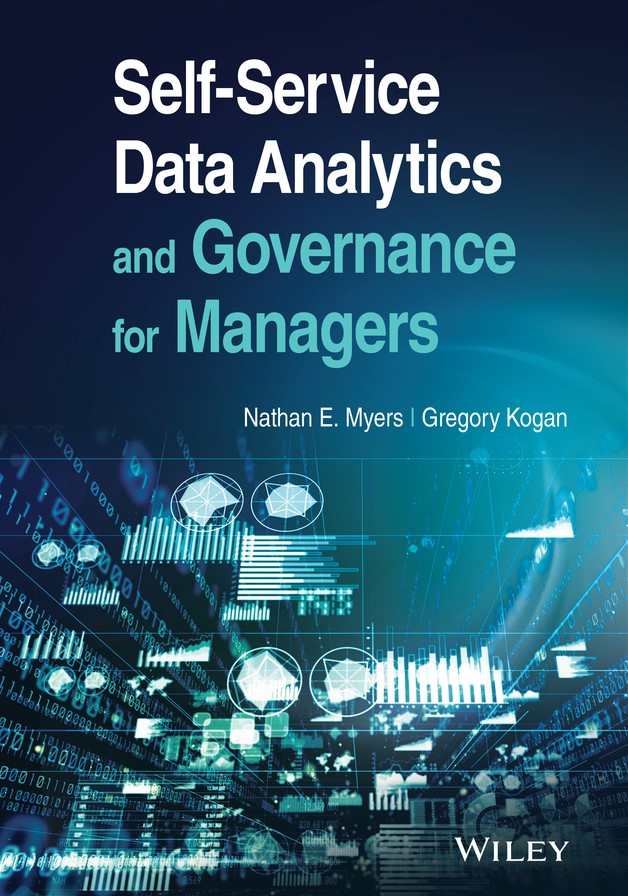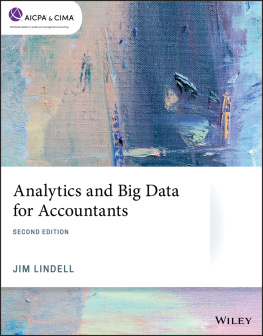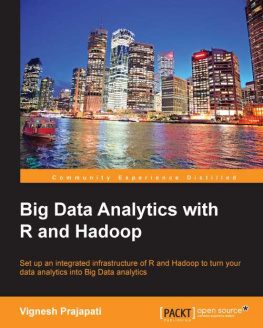Nathan E. Myers - Self-Service Data Analytics and Governance for Managers
Here you can read online Nathan E. Myers - Self-Service Data Analytics and Governance for Managers full text of the book (entire story) in english for free. Download pdf and epub, get meaning, cover and reviews about this ebook. year: 2021, genre: Business. Description of the work, (preface) as well as reviews are available. Best literature library LitArk.com created for fans of good reading and offers a wide selection of genres:
Romance novel
Science fiction
Adventure
Detective
Science
History
Home and family
Prose
Art
Politics
Computer
Non-fiction
Religion
Business
Children
Humor
Choose a favorite category and find really read worthwhile books. Enjoy immersion in the world of imagination, feel the emotions of the characters or learn something new for yourself, make an fascinating discovery.

- Book:Self-Service Data Analytics and Governance for Managers
- Author:
- Genre:
- Year:2021
- Rating:3 / 5
- Favourites:Add to favourites
- Your mark:
- 60
- 1
- 2
- 3
- 4
- 5
Self-Service Data Analytics and Governance for Managers: summary, description and annotation
We offer to read an annotation, description, summary or preface (depends on what the author of the book "Self-Service Data Analytics and Governance for Managers" wrote himself). If you haven't found the necessary information about the book — write in the comments, we will try to find it.
Self-Service Data Analytics and Governance for Managers — read online for free the complete book (whole text) full work
Below is the text of the book, divided by pages. System saving the place of the last page read, allows you to conveniently read the book "Self-Service Data Analytics and Governance for Managers" online for free, without having to search again every time where you left off. Put a bookmark, and you can go to the page where you finished reading at any time.
Font size:
Interval:
Bookmark:

- Chapter 1
- Chapter 3
- Chapter 4
- Chapter 5
- Chapter 6
- Chapter 7
- Chapter 8
NATHAN E. MYERS
GREGORY KOGAN

Copyright 2021 by John Wiley & Sons, Inc. All rights reserved.
Published by John Wiley & Sons, Inc., Hoboken, New Jersey.
Published simultaneously in Canada.
No part of this publication may be reproduced, stored in a retrieval system, or transmitted in any form or by any means, electronic, mechanical, photocopying, recording, scanning, or otherwise, except as permitted under Section 107 or 108 of the 1976 United States Copyright Act, without either the prior written permission of the Publisher, or authorization through payment of the appropriate per-copy fee to the Copyright Clearance Center, Inc., 222 Rosewood Drive, Danvers, MA 01923, (978) 750-8400, fax (978) 646-8600, or on the Web at www.copyright.com. Requests to the Publisher for permission should be addressed to the Permissions Department, John Wiley & Sons, Inc., 111 River Street, Hoboken, NJ 07030, (201) 748-6011, fax (201) 748-6008, or online at www.wiley.com/go/permissions.
Limit of Liability/Disclaimer of Warranty: While the publisher and author have used their best efforts in preparing this book, they make no representations or warranties with respect to the accuracy or completeness of the contents of this book and specifically disclaim any implied warranties of merchantability or fitness for a particular purpose. No warranty may be created or extended by sales representatives or written sales materials. The advice and strategies contained herein may not be suitable for your situation. You should consult with a professional where appropriate. Neither the publisher nor author shall be liable for any loss of profit or any other commercial damages, including but not limited to special, incidental, consequential, or other damages.
For general information on our other products and services or for technical support, please contact our Customer Care Department within the United States at (800) 762-2974, outside the United States at (317) 572-3993, or fax (317) 572-4002.
Wiley publishes in a variety of print and electronic formats and by print-on-demand. Some material included with standard print versions of this book may not be included in e-books or in print-on-demand. If this book refers to media such as a CD or DVD that is not included in the version you purchased, you may download this material at http://booksupport.wiley.com. For more information about Wiley products, visit www.wiley.com.
Library of Congress Cataloging-in-Publication Data is Available:
ISBN 9781119773290 (hardback)
ISBN 9781119773313 (ePDF)
ISBN 9781119773306 (epub)
Cover image: imetamorworks/iStock/Getty Images
Cover design: Wiley
My wife, Grazia, my son, Joseph, and our new daughter, Nicole Emma, who arrived just in time to keep me company during this project.
Nathan E. Myers
To my parents, Asya and Yaakov, my wife Carolyn and children Lucia and Matthias. Thank you for all your love and support.
Gregory Kogan
The breadth and scale of data are growing exponentially, and the growth of data is impacting the shape of organizations. According to the On Risk 2020 report by the IIA, Organizations face significant disruption driven by the accelerating pace of technology and the growing ease of mass data collection. Executives are placing increased reliance on the abundance of data in their decision-making process. A number of factors are driving the steep growth of data: data and metadata created and captured from the Internet of Things (IoT), increasingly interconnected supply chains, proprietary company information generated in unified ERPs, and the increasing number of third-party cloud data sources available for subscription and consumption. Organizations have available far more data than ever before.
The rise of data analytics is transforming business functions in an accelerated pace. This transformation is driven by managements' strategic goal of evolving their organizations to being data-driven, interconnected, and innovative in their approach to unlocking insights from the rapidly increasing volume of data. While data analytics is an extremely broad category of technologies and disciplines, self-service analytics has recently emerged as a significant driver of accelerated digital transformation. At the heart of digital transformation in accounting, finance, and operations functions is the move from manual spreadsheet-based data processing to structured, robust, and efficient automated processing using self-service analytics tools. Business professionals who spend their days assembling and enriching information from disparate sources in spreadsheets, performing routine formulaic processing steps, comparisons, and aggregations, now have data analytics tools at their disposal to rapidly automate the least value-added portions of their roles.
Even though automation techniques through core IT systems have existed for decades, the defining features of the new wave of self-service analytics automation is that it is small. Small automation is relatively inexpensive from a capital investment perspective compared to multi-million-dollar enterprise IT investments. Self-service data analytics offers flexible, no-code, low-cost processing capabilities that are directly accessible to process owners outside of IT. Without the need to involve IT or to await the technology investment cycle, self-service data analytics solutions can be developed and implemented in only hours or days directly by those overseeing the process. Such capabilities allow for dramatic acceleration of routine processes and reduce the likelihood that manual processing errors are introduced. Perhaps most importantly, they transform the role of business professionals who can reclaim time to focus on higher-order data analysis, the implementation of improved controls, or on other emerging business priorities. These benefits taken together amount to a quantum leap forward for organizations intent on truly harnessing data capabilities and optimally deploying human capital.
While self-service data analytics deployments can improve process control and efficiency in the finance function, they also markedly impact the internal control environment. In the past, the control environment which safeguarded the enterprise from IT general and application risks was centralized around the core technology stack. As processing capabilities are now placed directly into the hands of end-users to import and analyze data, structure processing steps, and export outputs, the risk environment has been dramatically shifted. Robust internal control governance built around systems over several decades has been side-stepped by increased data analytics processing outside of systems, necessitating a commensurate shift in governance. We will systematically inventory the body of existing regulatory guidance, legacy IT governance precepts, and data governance and model governance frameworks to identify foundational principles which must be extended to forge a data analytics governance framework. Building upon existing governance literature, we will outline the first comprehensive, fit-for-purpose, and actionable data analytics governance framework for managing the governance triad: project governance, risk governance, and investment governance.
Next pageFont size:
Interval:
Bookmark:
Similar books «Self-Service Data Analytics and Governance for Managers»
Look at similar books to Self-Service Data Analytics and Governance for Managers. We have selected literature similar in name and meaning in the hope of providing readers with more options to find new, interesting, not yet read works.
Discussion, reviews of the book Self-Service Data Analytics and Governance for Managers and just readers' own opinions. Leave your comments, write what you think about the work, its meaning or the main characters. Specify what exactly you liked and what you didn't like, and why you think so.









